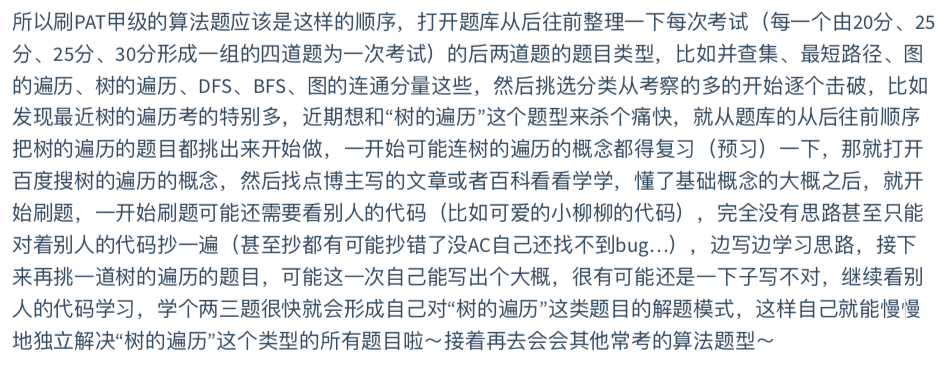2019.5.12
柳神推荐的甲级题库刷题方法:PAT甲级共155道题目

##”树的遍历”
###题目集合
1151、1147、1138、1127、1119、1115、1106、1102、1094、1090、1086、1079、1076、1053、1020、1004
踩坑记录
A1020Tree Traversals
1.判断左右子树是否为空,不能用”!root->lchild”,只能用”root->lchild != NULL”
2.层序遍历中最后不要空格,通过”计数”来实现格式控制
####A1053Path of Equal Weight
1.主要是DFS函数的编写,依据“sum与S”的三种关系进行处理,在”sum==S”的情况中要注意是否遍历到叶子结点的判断。
A1151LCA in a Binary Tree
1.已知中序与先序、后序、层序任意一种建树,注意临时的根节点申明为:
1 | node* root = new node; |
2.已知中序遍历与先序遍历构建树的简便方法
1 | //其中inl与inr为中序遍历的左端元素和右端元素 |
A1147Heaps
1.层序遍历数组[0…n-1]中,父结点序号和左右子结点序号的关系:left=parentX2+1;right=parentX2+2
若为[1…n]中,父结点序号和左右子结点序号的关系:left=parentX2;right=parentX2+1
2.不用构建树的话,直接pre.resize(n),不用pre.resize(n+1);
3.后序遍历的递归写法-注意格式的控制技巧
root==0的时候说明输出到最后一个数,则换行;否则只输出空格
A1138Postorder Traversal
1.由遍历序列建树,找出根节点在中序遍历中的位置
1 | for(int i=inL;i<=inR;i++){} |
2.已知前序和中序,求后序-熟悉简单写法,抛弃算法笔记的复杂写法
1 | //参数只需要prel,inl,inr |
A1127ZigZagging on a Tree
1.建树-需要记录节点层数的版本
1 | //结点的结构-不用左右子结点 |
A1119Pre- and Post-order Traversals
1.判断树是否唯一的依据——一个结点可能是根的左孩子也可能是根的右孩子——找左子树和右子树的根结点,如果相同,则不唯一,假设为右子树根结点;如果不相同,则唯一,继续递归建树
注意:递归边界
1 | if(preLeft==preRight) |
A1115Counting Nodes in a BST
1.递归建树的递归边界先写好”return”,不管有没有其他语句,非常容易忽略
2.BST建树的递归模板-思路:输入一个值,插入一个结点
1 | //递归建树-BST-可作为模板 |
3.连续定义两个指针变量,*的位置要变化
1 | struct node |
4.DFS方法记录一棵树对应层数中的结点数——思路:声明一个二维数组num[]
####A1106Lowest Price in Supply Chain
1.树以邻接表的形式存储
1 | //结点个数 |
2.根据题目要求的两个限制条件——深度最小、叶子结点——写出判断条件
1 | void dfs(int index,int depth) |
A1102 Invert a Binary Tree
1.Google: 90% of our engineers use the software you wrote (Homebrew), but you can’t invert a binary tree on a whiteboard so fuck off.
2.翻转二叉树的基本思想:在存储的时候所有左右结点都交换——使用RNL的遍历方式即可反转二叉树
1 | void dfs(int root,int index,int level) |
3.根结点是所有左右结点中没有出现的那个结点
A1094The Largest Generation
1.找出包含结点最多的那层,并输出层数和该层的结点总数
2.根据输入以邻接表表示树 + BFS统计每层的结点数 + 输出
1 | //邻接表表示树v[index][i] |
A1090Highest Price in Supply Chain
1.邻接表存储树 + 最大层数以及最大层数的结点数
2.each number Si is the index of the supplier for the i-th member. Sroot for the root supplier is defined to be −1.——Si是i的父节点,Sroot是根结点
3.关键的dfs代码
1 | void dfs(int index,int depth) |
4.r%在输出的时候要注意”r/100”
A1086Tree Traversals Again
1.栈的形式给出一棵二叉树的建立过程-(1) 栈pop输出的顺序的中序遍历(左根右) (2) 栈push输入的顺序是二叉树的前序遍历(根左右)——实际上是前序+中序->后序
2.题目没有说树中的结点值全部不相同——前中后序存储索引值,value数组中存储具体的值,因为索引值一定是不相同的。
A1079Total Sales of Supply Chain
1.统计所有叶子的层数
A1076Forwards on Weibo
1.待做
A1004Counting Leaves
1.待做